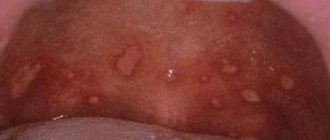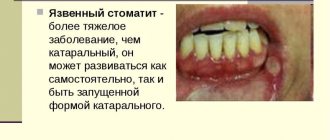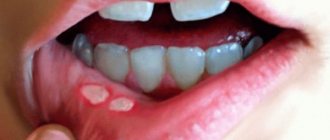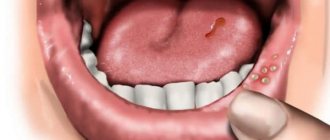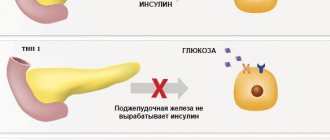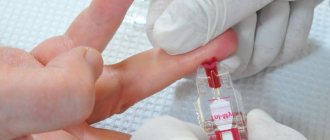Causes
People without medical education usually know about the existence of such a disease as stomatitis, and this is the diagnosis they make themselves when ulcers appear in the mouth.
Experts recommend, however, not to delay medical help, since there are even several different types of stomatitis (aphthous, allergic, vesicular, herpetic, catarrhal and others), and there are other diseases that create problems in the patient’s mouth, and for each case special treatment is required.
Take, for example, Vincent's ulcerative-necrotizing stomatitis, the cause of which is the simultaneous effect on the oral mucosa of the spindle-shaped rod and spirochete present in it (the disease often occurs simultaneously with teething).
We talked about the treatment of candidal stomatitis in adults and children here.
As for the reasons for the appearance of signs of aphthous stomatitis in a person, one of the main ones (against the background of which the infection is especially active) is a weakened immune defense.
If this factor exists, there will definitely be a reason to provoke the disease. They could be:
- past illnesses (ARVI, herpes);
- chronic diseases of the digestive system (the likelihood of getting sick increases with a stomach ulcer);
- injuries (scratches due to a broken tooth, “sharp” fillings, burns from food);
- lack of necessary elements in food that would protect the body from such infections (vitamins, selenium, iron, folic acid);
- nervous exhaustion;
- in women – hormonal changes (menopause, pregnancy, breastfeeding).
If the patient’s immunity cannot be restored, then stomatitis (even cured) can take on a chronic, recurrent nature and return again.
Types of disease taking into account the causes of allergic stomatitis
Contact
Appears due to direct exposure of the allergen to the mucous membrane: plastic or dyes of dentures, filling materials, dental solutions, medicinal gels, local anesthetics, toothpastes. Inflammation is localized in any part of the oral cavity and usually develops as a delayed allergic reaction. Contact stomatitis occurs in catarrhal or catarrhal-hemorrhagic form, and cure occurs after cessation of direct contact with the allergic agent.
Aphthous
It develops due to disorders in the immune system, as a result of which the immune system cannot recognize the molecules present in saliva, identifies them as foreign and triggers a cascade of inflammatory reactions, leading to the formation of aphthae and erosions on the mucous membrane. This type of inflammation develops due to the consumption of certain foods: citrus fruits, pineapples, bananas, seafood, spices, food additives, foods enriched with gluten (wheat, barley).
Medication
Occurs with repeated contact with a drug, which leads to sensitization of the body and the synthesis of specific antibodies. The period of sensitization takes 10-20 days, after which the clinical picture of an allergic reaction develops.
Most often, pathology is caused by oral administration of pharmacological drugs: antibacterial drugs, enzymes, iodine preparations. The pathology is catarrhal, bullous or ulcerative in nature, and along with damage to the oral mucosa, damage to other organs and systems can develop (Quincke's edema, vasculitis, gastritis).
Toxic-allergic
It occurs in two forms: fulminant (like Quincke's edema) and delayed. The cause of toxic-allergic inflammation is the prolonged presence of the allergen in the body or its repeated exposure. Medications, food agents, bacterial or viral toxins, chronic poisoning with heavy metal salts can act as a sensitizing agent. Stomatitis of this form occurs as an erosive or ulcerative-necrotic form. Often, inflammation of the oral mucosa is accompanied by lesions of the lips and corners of the mouth.
Chronic
It most often develops after aphthous inflammation, which is prone to chronicity of the process in the absence of treatment for the infections that caused this pathology. Chronic stomatitis is characterized by the formation of vesicles or erosions that heal in 10-12 days. The disease has a wave-like nature: periods of remission are replaced by exacerbations, usually occurring in the spring and autumn.
Over time, symptoms progress and the disease becomes severe. It most often develops when the infectious focus is localized in the gastrointestinal tract (Helicobacter pylori gastritis, bacterial overgrowth syndrome).
Autoimmune
It is one of the manifestations of autoimmune diseases (systemic lupus erythematosus, systemic scleroderma, lichen planus), developing due to failures in the immune system and the production of antibodies against the body’s own cells. Autoimmune stomatitis has a long course, is prone to frequent exacerbations, and with relapses, clinical symptoms can persist for up to several months. It usually occurs in a bullous and erosive form.
Photo of ulcerative stomatitis
Symptoms
The sick person does not immediately manage to correctly understand what happened to him. The first symptoms resemble acute respiratory infections, you feel lethargic and have a sore throat.
Soon these symptoms are supplemented by a burning sensation in the mouth, and it becomes difficult to eat and even talk.
Aphthae (ulcers) appear on the upper palate, lips, on the inside of the cheeks, on the tonsils, on the tongue and under the tongue. Salivation increases, and the smell from the mouth becomes unpleasant.
In adults and children, despite the similarity of symptoms, the disease progresses differently. If in young patients the disease can cause a temperature of up to 38-39 degrees, enlarged lymph nodes (they even become painful), then in adults these signs are usually absent.
The healing period for ulcers lasts about 10 days . Usually they disappear without a trace, but there are cases of scars forming in their place.
This occurs more often in adult patients, especially if the disease becomes chronic. In this case, the lesions of the mucous membrane are very serious, their area of distribution is large, and the healing and scarring process can last up to 3 weeks.
The characteristic state of “chronicles” is weakness, deterioration in performance, low-grade fever (37-38 degrees for a long period of time).
Causes of herpetic stomatitis
According to the etiology of the disease, it is classified as viral stomatitis, and the cause is herpes simplex virus (herpesvirus) type 1 (HSV-1). Much less frequently, in 10% of cases, the cause may be infection with herpes virus type 2 (HSV-2). The first encounter (primary infection) with the virus occurs at an early age, through direct contact with a carrier of the virus or through household objects, and by the age of 15, infection reaches 90-95%. Primary infection can occur unnoticed, but with reduced immunity it can cause acute herpetic stomatitis . Subsequently, the virus goes into a latent state, remains in the body for life, and may not cause any damage. But in situations and during periods when immunity is significantly reduced, activation of the virus in the form of recurrent herpetic stomatitis with damage to part of the mucous membrane (herpes in the oral cavity) or herpetic lesions on the lips is possible.
Outside the body, herpes viruses are very stable; at room (ordinary) temperature they remain active for one day and for several days at low (for example, -50 degrees) temperatures. Easily transmitted by airborne droplets or contact, i.e. Herpes infection occurs very easily and is difficult to avoid.
Who is at risk
Predisposition to this disease is often inherited.
Any forum on the Internet containing reviews on how to quickly and effectively cope with the disease cites cases like “I myself have always had this problem, but now I had to treat my child for aphthous stomatitis.”
Women are the first at risk; they are diagnosed with this disease more often than men. If we talk about the age preferences of stomatitis, it prefers teenagers, although both children and the elderly can get sick.
Who else is at risk of getting an unpleasant diagnosis? Anyone who does not care about oral hygiene abuses alcohol and smokes.
The etiology of aphthous stomatitis does not exclude allergies to a number of foods as one of the common causes.
Symptoms of aphthous stomatitis
Usually, 1–2 days before the appearance of aphthae, areas of the mucous membrane with increased sensitivity are detected, and a burning sensation may occur. The aphthae themselves are round, have clear boundaries, and are covered with a gray or yellowish coating. Their size, as a rule, does not exceed 1 cm, and the mucous membranes around them turn red.
Such areas of erosion heal within up to 2 weeks without scarring. But in 1 case out of 10, the diameter of the ulcers is more than 1 cm, they affect deeper areas of tissue, and the borders of the pathological area may look raised. Healing in this case takes up to 6 weeks, after which a scar forms.
Aphthous stomatitis is characterized by damage to the mucous membranes of the cheeks, the inside of the lips, the soft palate, tonsils, and the lateral surfaces of the tongue. This is due to the lack of keratinization of the epithelium in these areas. Much less often, aphthae appear on the hard palate, back of the tongue, and gums.
Classification: forms, types, stages
Varieties of aphthous stomatitis are distinguished by the localization of aphthae: on the tongue, palate, gum.
There is also a division into chronic and acute forms. Acute stomatitis, as a rule, is associated with a recent illness and the presence of staphylococci and streptococci in the mucous membranes.
Chronic infection bothers a person for years, when relapses give way to remission, but it is not possible to completely get rid of the infection.
There are several forms of the disease:
- fibrous - resembles the symptoms of herpetic stomatitis, in which ulcers (unlike aphthous) are located on the outside of the lips;
- necrotic - severe, lasts about a month;
- grandular - ulcers appear in place of the salivary glands and block the ducts, the disease lasts up to three weeks;
- cicatrizing - a consequence of improper treatment of the granular form, the size of the ulcers reaches one and a half centimeters, treatment lasts for 3 months;
- deforming - characterized by changes in the connective tissues of the lips (on the inside) and palate, it is difficult to treat and does not go away for a long time.
The disease includes a number of stages:
- prodromal – from the first signs to the manifestation of all symptoms,
- aphthous - when ulcers form,
- healing stage.
Find the causes, symptoms and photos of herpes in the throat of a child in this article.
Indications for the use of Flucinar ointment, contraindications and side effects are described in this publication.
Photos of herpetic sore throat in children are presented here: https://udermatologa.com/zabol/gerp/gerpesnaya-gerpeticheskaya-angina-foto-lechenie-simptomy/
Kinds
There are two forms of aphthous stomatitis, each of which requires a special approach to treatment.
The nature of the disease also differs in each case. So, the disease has two forms:
- Spicy. It is an erosion that has formed in the oral cavity and damaged the integrity of the mucous membrane. In the acute form of aphthous stomatitis, aphthae form one after another. This process is accompanied by a strong burning sensation and painful sensations that are constantly increasing. A person cannot eat or even speak calmly, which brings a lot of discomfort. Often complications of the acute form of the disease include a sharp increase in lymph nodes and an increase in body temperature;
- Chronic. It is the result of incorrect treatment or neglect of the acute form of aphthous stomatitis. When the disease becomes chronic, it constantly manifests itself, from time to time “reminding” itself by the formation of new aphthae. Typically, this form is acquired as a result of reduced immunity or the presence of chronic systemic diseases that weaken the body's protective functions. Chronic aphthous stomatitis is sluggish, different symptoms appear at different times, so in this case, therapy is prescribed for continuous treatment.
Diagnostics
A quick cure for the disease is possible only as a result of a competent diagnosis. As a rule, this is done by a dentist.
The necessary information is given to him by a visual examination (what the affected mucous membrane looks like), a questioning of the patient (how long ago did the symptoms of the disease appear, whether they were accompanied by an increase in temperature).
In difficult cases, as well as if it is necessary to decide what to do next, if the healing process is delayed, laboratory blood tests, biopsy, and bacteriological culture are performed.
Description
Ulcerative stomatitis.
An inflammatory disease of the oral cavity, accompanied by focal destruction of the mucous membrane. Ulcerative stomatitis is manifested by swelling and hyperemia of the oral mucosa, against which single or multiple bleeding and painful ulcers are formed, covered with plaque. The ulcerative process is accompanied by halitosis, fever, and regional lymphadenitis. Diagnosis of ulcerative stomatitis includes a dental examination and examination of scrapings of the mucous membrane. Treatment of ulcerative stomatitis consists of local treatment of ulcers and the oral cavity with anesthetics, antimicrobial drugs and proteolytic enzymes; if necessary, antibiotics, antihistamines, and multivitamins are indicated.
Treatment of aphthous stomatitis in adults and children
In both children and adults, stomatitis is usually treated at home, using both pharmaceutical drugs and folk remedies.
Homeopathy helps some, while for others the doctor prescribes electrophoresis or laser therapy.
Much when developing treatment tactics depends on the individual characteristics of the patient, the responsiveness of his body to a particular medicine or procedure.
Medication
For hygienic cleaning of the mouth, antiseptics are used:
- hydrogen peroxide;
- Decamethoxin;
- Furacilin;
- Chlorhexidine.
To treat wounds at the initial stage of the disease, an ointment, gel or spray is usually used:
- Solcoseryl;
- Holisal;
- Metrogil Denta;
- Kamistad;
- Stomatophyte;
- Actovegin.
If the problem cannot be solved quickly, antibacterial drugs Tantum Verde and Hexoral are used.
To support immunity:
- Immunal;
- Thymogen;
- Taktivin;
- Imudon.
Acyclovir, which has a reputation as an effective remedy in the fight against herpetic stomatitis (you can read about this disease in a separate article), does not give the necessary result in the case of aphthous stomatitis.
Folk remedies
For any form of stomatitis, folk remedies are actively used, mainly to improve the patient’s condition:
- wounds are treated with healing oils of sea buckthorn and rosehip;
- parsley root is used to prepare a decoction, which is used to rinse the mouth and take orally (a tablespoon three times a day);
- decoctions of chamomile, calendula, and eryngium flatifolia are used as rinses;
- an aloe leaf with the spines removed is chewed to destroy pathogenic bacteria;
- alcohol tinctures of various medicinal herbs are used for rinsing, adding 20-30 drops to half a glass of water.
A detailed review of shampoos for seborrhea of the scalp is presented in this material.
If you are interested in why herpes on the fingers occurs and how to treat it, be sure to read our publication.
Diet
Nutrition plays an important role in the treatment of stomatitis. In addition to the fact that the foods are designed to strengthen the patient’s body and help him cope with infection, they must be prepared in a special way so as not to injure the inflamed mucous membranes.
Patients usually complain that food is difficult to chew and swallow. The solution to the problem can be puree soup, liquid porridge, jelly, compote.
Anything that irritates the mucous membranes - salty, spicy, sour foods and drinks - is excluded from the menu.
Acute herpetic stomatitis: Treatment methods
Treatment
Regime and diet
It is necessary to follow a diet: predominantly liquid or semi-liquid food and plenty of liquid (tea, fruit juices, fruit infusions). Before feeding, the oral mucosa is anesthetized with a 5% anesthetic emulsion. After eating, be sure to wash or rinse your mouth.
Drug treatment
Determined by the stage and severity of the process. It is recommended to treat the child’s oral cavity with proteolytic enzymes (trypsin, chymopsin, pancreatin, etc.) that help dissolve plaque, and IFN. Applications are made with antiviral ointments (oxalic, bonaftone, etc.). Later keratoplasty is used. General treatment is required, including antiviral drugs and vitamins.
Forecast
Usually favorable. An unstable, non-sterile immunity occurs. The herpes virus usually remains in the body for life. Transition to a chronic form is possible.
How to treat infants and women during pregnancy
Compliance with a diet by patients with aphthous stomatitis is especially important for expectant mothers - they should never refuse food because it is difficult to chew and swallow; this can negatively affect the development of the child.
Pregnant women are recommended warm meat broths, liquid oatmeal and, in addition to this, vitamin complexes designed specifically for expectant mothers.
The doctor’s task is to treat the patient with means that are safe for the fetus and ensure stable remission. It is the doctor, not the patient, who will select effective medications.
If, for example, you need to bring down the temperature, then it will not be antibiotic tablets, but special antipyretic suppositories. And mouthwashes, which are usually prepared at home from herbs, should exclude plants that cause allergies.
Children under three years old rarely suffer from aphthous stomatitis. Sometimes the disease manifests itself as a complication of diphtheria, whooping cough, measles, and influenza.
In children under one year old, and the famous pediatrician Komarovsky insists on this, parents become the culprits of the disease, transmitting the infection to their child through a kiss.
The disease progresses in waves: new rashes provoke a rise in temperature.
What does the doctor advise? In addition to drug treatment prescribed by the local doctor, the following are necessary: ventilation and humidification of the air, rinsing the mouth (if the child already knows how to do this), vitamin puree from fresh fruits and vegetables.
